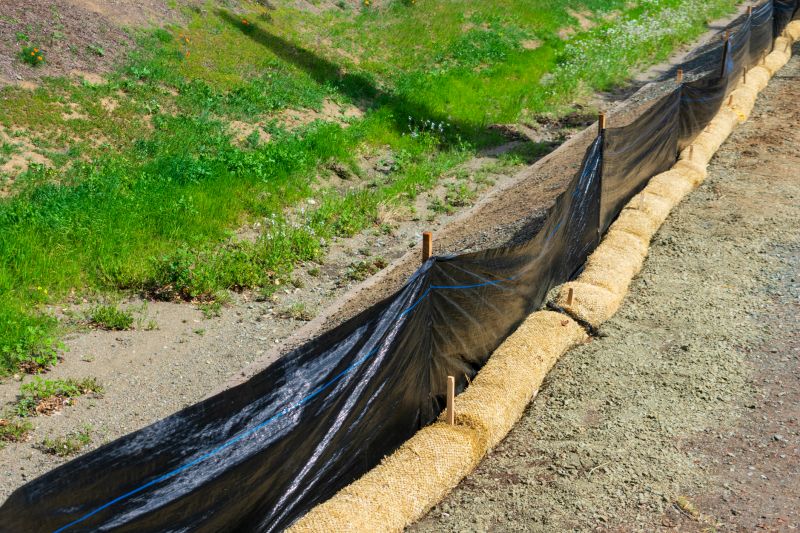Favorite Silt Fence Installation Tools and Materials for Contractors
Browse essential equipment and supplies trusted by professionals for effective silt fence setup and maintenance.
 Installing silt fences is a critical step in managing soil erosion and sediment control during construction, landscaping, or land development projects. The effectiveness of a silt fence depends heavily on the quality and suitability of the products used, as well as proper installation techniques. There are various types of materials and accessories designed to enhance the durability, stability, and functionality of silt fences, ensuring they perform as intended under different site conditions. Selecting the right products requires understanding the specific requirements of the project, including soil type, slope, water flow, and environmental factors.
Installing silt fences is a critical step in managing soil erosion and sediment control during construction, landscaping, or land development projects. The effectiveness of a silt fence depends heavily on the quality and suitability of the products used, as well as proper installation techniques. There are various types of materials and accessories designed to enhance the durability, stability, and functionality of silt fences, ensuring they perform as intended under different site conditions. Selecting the right products requires understanding the specific requirements of the project, including soil type, slope, water flow, and environmental factors.
Top Overall Option
High-Strength Silt Fence Fabric
A durable, heavy-duty fabric designed for reliable sediment control across various site conditions. Its robust construction offers resistance to tearing and UV degradation, making it suitable for both temporary and long-term installations. Paired with compatible stakes and support accessories, this fabric provides a flexible and effective solution for erosion management.
Types of Products For Silt Fence Installations
Woven Polypropylene Silt Fence
A common choice for sediment control, offering good permeability and strength for various applications.
Non-Woven Geotextile Fabric
Provides excellent filtration and soil stabilization, suitable for more demanding erosion control projects.
Steel Stakes and Supports
Heavy-duty stakes designed to securely anchor the fence fabric into the ground, ensuring stability.
Plastic Fence Posts
Lightweight, corrosion-resistant posts that facilitate quick installation and easy adjustments.
Fabric Clips and Ties
Accessories used to attach fencing fabric to support stakes or posts securely.
Support Wires and Cables
Used to reinforce the fence and maintain tension over long spans or uneven terrain.
Erosion Control Blankets
Complementary products that provide additional stabilization on slopes and disturbed soil areas.
Heavy-Duty Anchors
Used to secure the fence fabric in areas with high water flow or loose soil conditions.
Water Flow Baffles
Designed to slow water movement and reduce pressure on the fence during heavy rain.
Corner and End Supports
Specialized fittings for securing fence ends and corners to maintain integrity.
Popular Choices
Widely used for sediment control, appreciated for its balance of strength and permeability.
Commonly selected for their durability and ease of installation in various soil types.
Preferred for projects requiring high filtration and soil stabilization capabilities.
Favored for quick setup and resistance to corrosion, suitable for temporary fencing needs.
Essential accessories for securing fabric to supports, ensuring a tight and reliable installation.
Used to maintain tension and prevent sagging over long stretches of fencing.
Often paired with fencing to provide comprehensive erosion management on slopes.
Selected for securing fences in high-flow or loose soil areas to prevent displacement.
Trending for their ability to reduce water pressure and improve fence longevity.
Popular for ensuring stability at fence corners and ends, especially on irregular sites.
Silt fence products can vary widely in terms of material composition, mesh size, reinforcement features, and installation accessories. Some fences are designed for temporary use, while others are suitable for longer-term applications. Accessories such as stakes, anchors, and fabric clips are often necessary to secure the fence in place and prevent failure. Proper installation not only maximizes the effectiveness of the silt fence but also helps in complying with local regulations and standards.
In addition to the fencing material itself, there are complementary products that facilitate installation and improve performance. These include specialized posts, fabric ties, and support systems that ensure the fence remains stable during adverse weather conditions or high water flow. Choosing products that are easy to handle and install can save time and labor costs while ensuring a secure and reliable sediment control barrier. Overall, the right combination of products can make a significant difference in the success of erosion control measures on any site.
Key Buying Considerations
- Assess the soil type and drainage conditions to select appropriate fencing material and support accessories.
- Determine the expected duration of use — temporary fences may require different materials than long-term installations.
- Consider the permeability and filtration capacity of the fabric to ensure sediment retention without excessive water pooling.
- Evaluate the strength and tear resistance of the fabric, especially in areas prone to high water flow or physical stress.
- Choose compatible support stakes, posts, and anchors that match the fencing material for secure installation.
- Ease of installation can save time; look for products with straightforward assembly and minimal tools required.
- Weather resistance, including UV stability and resistance to moisture, extends the lifespan of the fencing system.
- Compatibility with other erosion control products, such as blankets or mats, can enhance overall effectiveness.
- Check local regulations or project specifications for specific product requirements or standards.
- Availability of replacement parts and accessories can facilitate maintenance and adjustments over time.
- Consider the environmental conditions, such as wind or snow, which may influence the fencing design and anchoring needs.
- Cost-effectiveness involves balancing material quality with budget constraints, ensuring reliable performance.
- Durability and resistance to degradation are vital for maintaining sediment control during adverse weather.
- Size and roll length of fabric should match the scope of the project to avoid unnecessary waste or multiple joins.
- Availability of technical support or guidance from suppliers can aid in proper installation and troubleshooting.
